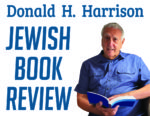Fighting Back: Stan Andrews and the Birth of the Israeli Air Force by Jeffrey Weiss and Craig Weiss; Wicked Son Book of Post Hill Press; © 2022; ISBN 9781637-583111; 237 pages; $30.

 SAN DIEGO –Some will call Stan Andrews a hero because he fought and gave his life for Israel during that country’s War of Independence. Others will call him a fool because he lusted after combat with the same recklessness that he pursued and casually bedded women.
SAN DIEGO –Some will call Stan Andrews a hero because he fought and gave his life for Israel during that country’s War of Independence. Others will call him a fool because he lusted after combat with the same recklessness that he pursued and casually bedded women.
The truth lies somewhere in between the two assessments. Through meticulous research, the authors pieced together a complex portrait of a young man who was an accomplished writer, portraitist, and pilot.
Ambivalent about the Judaism into which he was born, and less than convinced that Zionism was a good idea, Andrews (ne Anekstein) served as a bomber pilot in the Pacific theatre during World War II, then returned to civilian life with the idea that his writing and his art might win him a job within the Hollywood film industry.
However, the desire to fight against antisemites—whose slurs he had tried to grin away—propelled him to volunteer for the yet-to-be-born Israeli air force. Czechoslovakia was the only country that would sell airplanes to Israel in the face of a U.S. embargo, so he made his way there, learned how to fly German-made Messerschmidts (an irony), then flew to post-Independence Israel to join in the fight against combined Arab forces seeking to extinguish the new Jewish state.
Andrews was grounded after an airplane he piloted crashed, leading to an assignment in which he was promoted to a major and through diplomacy and deceit fended off repeated requests from a United Nations mediator to inspect two airfields where Israel steadily was building up its air force.
He met and became friendly with such Israeli lions as Ezer Weizman, Chaim Herzog, and Yitzhak Rabin but his heart demanded action, not negotiation nor diplomacy. Violating his grounding, he talked his way on several occasions to be a third man in a cockpit built for two. On one such mission, their plane crashed and burned in a portion of the Negev near Ashkelon. The body of the pilot was recovered; Andrews’ body and that of the copilot were not.
Why did Andrews, seemingly so bent upon assimilation, decide to fight for the nascent state of Israel? He answered that question in a letter to a friend, in which he either ignored or was unaware of the Jewish resistance in the Warsaw Ghetto, in the forests of the partisans, and in the break-out from the Sobibor Concentration Camp:
“Merely admitting or even proclaiming loudly one’s Jewishness these days is not enough [to take a stand against antisemitism.} For one of the few times in history, there seems to be a definite opportunity to get in a few licks in the fight. The Jew has always been known as an intellectual, not a fighter, a turner of cheeks, a beggar for help against oppression, always the victim, never the victor. Every time there is an outbreak of anti-Semitism, a pogrom, or an organized campaign of extinction, what have the Jews done – passed resolutions, sent petitions, wrote letters, made speeches—and never fought. That can be pretty frustrating and a hell of a label to carry around with you . If, then, we can fight back, just once, I intend to do it.”
This book provides insight into a period of Israeli—and American—history, and helps us live it through one man’s passions.
*
Donald H. Harrison is editor emeritus of San Diego Jewish World. He may be contacted via donald.harrison@sdjewishworld.com